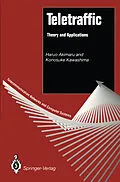Telecommunications systems have been evolving from the conventional telephone network that mainly deals with voice, to the ISDN (integrated services digital net work) integrating voice, data and image. Moreover, the ATM (asynchronous trans fer mode) and optical switching technologies are being developed for the broadband ISDN which can handle the high speed video communications as well. Computer networks are also progressing from centralized TSS (time-sharing system) to dis tributed LAN (local area network) and VAN (value added network). In the research, development, design and operation of such telecommunications and computer networks, the important problems are determining the optimum con figuration and dimensions of the systems for providing a given performance or GOS (grade of service). The teletraflic theory, the basis for the performance evaluation and the dimensioning, has been studied along with the switching technology, and has developed rapidly by incorporating the recent advances in OR (operations research) and queueing theory. However, it is sometimes difficult for non-experts of teletraffic to understand and apply these theories, because they require a deep mathematical background.
Inhalt
1 Introduction.- 1.1 Features of Teletraffic Systems.- 1.2 Modeling of Teletraffic Systems.- 1.2.1 Traffic Load.- 1.2.2 Call Origination Process.- 1.2.3 Service Time Distribution.- 1.2.4 Classification of Traffic Models.- 1.3 Fundamental Relations.- 1.3.1 Markov Property.- 1.3.2 PASTA.- 1.3.3 Little Formula.- Exercises.- 2 Markovian Models.- 2.1 Markovian Loss Systems.- 2.1.1 M/M/s(0).- 2.1.2 Statistical Equilibrium.- 2.1.3 M(n)/M/s(0).- 2.1.4 State Probabilities at Call Arrival.- 2.1.5 Blocking Probability.- 2.1.6 Ordered Trunk Hunting.- 2.2 Markovian Delay Systems.- 2.2.1 M/M/s.- 2.2.2 Mean Waiting Time.- 2.2.3 Waiting Time Distribution.- 2.3 Extended Markovian Models.- 2.3.1 Birth-Death Process.- 2.3.2 M(n)/M/s(m,?).- 2.3.3 M/M/s(m,?).- 2.3.4 M(n)/M/s.- 2.3.5 M/M/s(m).- Exercises.- 3 Non-Markovian Models.- 3.1 Renewal Process.- 3.1.1 Residual Time Distribution.- 3.1.2 Mean Residual Time.- 3.1.3 Rate Conservation Law.- 3.2 Poisson Input General Service Time Models.- 3.2.1 M/G/1.- 3.2.2 Embedded Markov Chain.- 3.2.3 State Probability at Call Departure.- 3.2.4 Waiting Time Distribution.- 3.2.5 M/G/1(m).- 3.3 Poisson Input Constant Service Time Model.- 3.3.1 M/D/s.- 3.3.2 State Probability Generating Function.- 3.3.3 Mean Waiting Time.- 3.3.4 Waiting Time Distribution.- 3.4 Renewal Input Exponential Server Models.- 3.4.1 GI/M/s(0).- 3.4.2 Blocking Probability.- 3.4.3 GI/M/s.- 3.4.4 Waiting Time Distribution.- 3.4.5 Derivation of Boundary Probability.- 3.5 Renewal Input Single Server Models.- 3.5.1 Spectral Solution for GI/G/1.- 3.5.2 H2/G/1.- 3.5.3 Ek/G/1.- Exercises.- 4 Multi-Class Input Models.- 4.1 Batch Arrival Models.- 4.1.1 M[X]/M/s(0).- 4.1.2 M[X]/G/1.- 4.1.3 GI[X]/G/1.- 4.2 Priority Models.- 4.2.1 Non-Preemptive Priority Model.- 4.2.2 Preemptive Priority Model.- 4.2.3 Work Conservation Law.- 4.3 Multi-Dimensional Traffic Models.- 4.3.1 Multi-Dimensional Traffic.- 4.3.2 Trunk Reservation System.- 4.3.3 Individual Performance Measures.- 4.4 Mixed Loss and Delay Systems.- 4.4.1 M1+M2/M/s(0,?).- 4.4.2 GI+M/M/s(?,0).- 4.4.3 GI+M/M/s(0,?).- 4.5 Multi-Queue Models.- 4.5.1 Modeling of Multi-Queue.- 4.5.2 Exhaustive Model.- 4.5.3 Gated Model.- 4.5.4 Limited Model.- Exercises.- 5 Alternative Routing Systems.- 5.1 Overflow System.- 5.1.1 Overflow Traffic Model.- 5.1.2 Moment and LST of Overflow Process.- 5.1.3 Mean and Variance of Overflow Calls.- 5.2 Approximate Methods for Overflow Systems.- 5.2.1 Equivalent Random Theory.- 5.2.2 Interrupted Poisson Process.- 5.2.3 GI Approximation.- 5.3 Optimum Design of Alternative Routing.- 5.3.1 Conventional Method.- 5.3.2 Given Blocking Probability.- 5.3.3 Trunk Reservation Scheme.- 5.4 Numerical Analysis of State Equations.- 5.4.1 State Equation for Alternative Routing.- 5.4.2 Gauss-Seidel Iteration.- 5.4.3 Solution for Trunk Reservation Scheme.- Exercises.- 6 Advanced Teletraffic Models.- 6.1 Renewal Input Multi-Server Model.- 6.1.1 Diffusion Model.- 6.1.2 Modified Diffusion Approximation.- 6.1.3 GI/G/s.- 6.2 PH-MRP Input Models.- 6.2.1 Phase-Type Markov Renewal Process.- 6.2.2 PH-MRP/M/s(m).- 6.2.3 M$$ M{\overset{\lower0.5em\hbox{$\smash{\scriptscriptstyle\leftarrow}$}}{ + }}PH - MRP{\text{ }}/{\text{ }}{{M}_{1}},{{M}_{2}}{\text{ }}/{\text{ }}s(\infty ,0)PPP(n) $$.- 6.2.4 Special Cases.- 6.3 MMPP Input Model.- 6.3.1 Markov Modulated Poisson Process.- 6.3.2 MMPP/G/1.- 6.3.3 Mean Waiting Times.- 6.4 Statistical Packet Multiplexer.- 6.4.1 Modeling of Packetized Process.- 6.4.2 Indices of Dispersion and Skewness.- 6.4.3 MMPP Approximation.- 6.4.4 MMPP + M/G/1.- 6.5 Local Area Networks.- 6.5.1 Token Ring LAN.- 6.5.2 Approximation for Asymmetric System.- 6.5.3 CSMA/CD LAN.- 6.5.4 Mean Access Time.- Exercises.- 7 Traffic Simulation.- 7.1 Introduction.- 7.2 Methods of Simulation.- 7.2.1 Problem Formulation and Modeling.- 7.2.2 Programming for Simulation.- 7.2.3 Simulation Language, GPSS.- 7.2.4 General Purpose Programming Languages.- 7.3 Generation of Random Numbers.- 7.3.1 Random Number Generation Methods.- 7.3.2 Uniform Random Number.- 7.3.3 Arbitrary Random Numbers.- 7.4 Analysis of Output Result.- 7.4.1 Confidence Interval.- 7.4.2 Replication Method.- 7.4.3 Batch Mean Method.- 7.4.4 Regenerative Method.- Exercises.- Appendices.- A Basic Teletraffic Formulas.- A.1 Notation.- A.2 Markovian Models.- A.3 Poisson Input Non-Markovian Models.- A.4 Renewal Input Non-Markovian Models.- A.5 Non-Renewal Input Models.- B Programs for Erlang B Formula.- B.1 Integer Number of Servers.- B.2 Real Number of Servers.- B.3 Derivatives of Erlang B Formula.- B.4 BASIC Program Lists.- C Basis of Probability Theory.- C.1 Events and Probability.- C.1.1 Events.- C.1.2 Probability.- C.1.3 Conditional Probability.- C.2 Distribution Functions.- C.2.1 Random Variables.- C.2.2 Joint Distribution Function.- C.2.3 Convolution.- C.3 Expectation and Transforms.- C.3.1 Expectation.- C.3.2 Laplace-Stieltjes Transform.- C.3.3 Probability Generating Function.- C.4 Examples of Probability Distributions.- C.4.1 Probability Distribution.- C.4.2 Discrete Distributions.- C.4.3 Continuous Distributions.- C.5 Stochastic Processes.- C.5.1 Markov Process.- C.5.2 Discrete-Time Markov Chain.- C.5.3 Continuous-Time Markov Chain.- C.5.4 Birth-Death Process.- D Solutions to Exercises.
